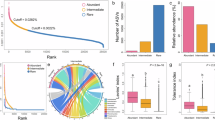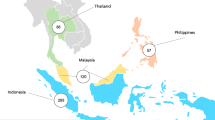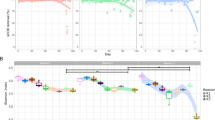Abstract
The mechanisms underlying community assembly and promoting temporal succession are often overlooked in microbial ecology. Here, we studied an undisturbed salt marsh chronosequence, spanning over a century of ecosystem development, to understand bacterial succession in soil. We used 16S rRNA gene-based quantitative PCR to determine bacterial abundance and multitag 454 pyrosequencing for community composition and diversity analyses. Despite 10-fold lower 16S rRNA gene abundances, the initial stages of soil development held higher phylogenetic diversities than the soil at late succession. Temporal variations in phylogenetic β-diversity were greater at initial stages of soil development, possibly as a result of the great dynamism imposed by the daily influence of the tide, promoting high immigration rates. Allogenic succession of bacterial communities was mostly driven by shifts in the soil physical structure, as well as variations in pH and salinity, which collectively explained 84.5% of the variation concerning community assemblage. The community assembly data for each successional stage were integrated into a network co-occurrence analysis, revealing higher complexity at initial stages, coinciding with great dynamism in turnover and environmental variability. Contrary to a spatial niche-based perspective of bacterial community assembly, we suggest temporal niche partitioning as the dominant mechanism of assembly (promoting more phylotype co-occurrence) in the initial stages of succession, where continuous environmental change results in the existence of multiple niches over short periods of time.
Similar content being viewed by others
Log in or create a free account to read this content
Gain free access to this article, as well as selected content from this journal and more on nature.com
or
References
Archer S, Scifres C, Bassham CR, Maggio R . (1988). Autogenic succession in a subtropical savanna: conversion of grassland to thorn woodland. Ecol Monogr 58: 111–127.
Bach HJ, Tomanova J, Schloter M, Munch JC . (2002). Enumeration of total bacteria and bacteria with genes for proteolytic activity in pure cultures and in environmental samples by quantitative PCR mediated amplification. J Microbiol Methods 49: 235–245.
Barberán A, Bates ST, Casamayor EO, Fierer N . (2012). Using network analysis to explore co-occurrence patterns in soil microbial communities. ISME J 6: 343–351.
Bastian M, Heymann S, Jacomy M . (2009). Gephi: An Open Source Software For Exploring and Manipulating Networks International AAAI Conference on Weblogs and Social Media. San Jose, CA, USA.
Bates ST, Berg-Lyons D, Caporaso JG, Walters WA, Knight R, Fierer N . (2011). Examining the global distribution of dominant archaeal populations in soil. ISME J 5: 908–917.
Begon M, Harper JL, Townsend CR . (1996) Ecology: Individuals, Populations and Communities. Blackwell Science: Cambridge, UK.
Bolhuis H, Stal LJ . (2011). Analysis of bacterial and archaeal diversity in coastal microbial mats using massive parallel 16S rRNA gene tag sequencing. ISME J 5: 1701–1712.
Bormann BT, Sidle RC . (1990). Changes in productivity and distribution of nutrients in a chronosequence at Glacier Bay National Park, Alaska. J Ecol 78: 561–578.
Bowen JL, Crump BC, Deegan LA, Hobbie JE . (2009). Salt marsh sediment bacteria: their distribution and response to external nutrient inputs. ISME J 3: 924–934.
Bowen JL, Morrison HG, Hobbie JE, Sogin ML . (2012). Salt marsh sediment diversity: a test of the variability of the rare biosphere among environmental replicates. ISME J 6: 2014–2023.
Brankatschk R, Töwe S, Kleineidam K, Schloter M, Zeyer J . (2011). Abundances and potential activities of nitrogen cycling microbial communities along a chronosequence of a glacier forefield. ISME J 5: 1025–1037.
Breen K, Lévesque E . (2006). Proglacial succession of biological soil crusts and vascular plants: biotic interactions in the High Arctic. Can J Bot 84: 1714–1731.
Brown JH, Lomolino MV . (1998) Biogeography 2nd edn Sinauer Associates: Sunderland, MA, USA.
Caporaso JG, Bittinger K, Bushman FD, DeSantis TZ, Andersen GL, Knight R . (2010a). PyNAST: a flexible tool for aligning sequences to a template alignment. Bioinformatics 26: 266–267.
Caporaso JG, Kuczynski J, Stombaugh J, Bittinger K, Bushman FD, Costello EK et al. (2010b). QIIME allows analysis of high-throughput community sequencing data. Nat Methods 7: 335–336.
Chaffron S, Rehrauer H, Pernthaler J, Von Mering C . (2010). A global network of coexisting microbes from environmental and whole-genome sequence data. Genome Res 20: 947–959.
Chapin FS, Walker LR, Fastie CL, Sharman LC . (1994). Mechanisms of primary succession following deglaciation at Glacier Bay, Alaska. Ecol Monogr 64: 149–175.
Chase JM . (2003). Community assembly: when should history matter? Oecologia 136: 489–498.
Clarke KR, Gorley RN . (2006) PRIMER 6th edn PRIMER-E Ltd.: Plymouth, UK.
Clements F . (1916) Plant Succession: An Analysis of the Development of Vegetation. Carnegie Institute: Washington DC, USA.
Cumming GS, Bodin Ö, Ernstson H, Elmqvist T . (2010). Network analysis in conservation biogeography: challenges and opportunities. Divers Distrib 16: 414–425.
Córdova-Kreylos AL, Cao Y, Green PG, Hwang H-M, Kuivila KM, LaMontagne MG et al. (2006). Diversity, composition, and geographical distribution of microbial communities in California salt marsh sediments. Appl Environ Microbiol 72: 3357–3366.
DeBruyn JM, Nixon LT, Fawaz MN, Johnson AM, Radosevich M . (2011). Global biogeography and quantitative seasonal dynamics of gemmatimonadetes in soil. Appl Environ Microb 77: 6295–6300.
Deiglmayr K, Phillippot L, Tscherko D, Kandeler E . (2006). Microbial succession of nitrate-reducing bacteria in the rhizosphere of Poa alpina across a glacier foreland in the Central Alps. Environ Microbiol 8: 1600–1612.
DeSantis TZ, Hugenholtz P, Larsen N, Rojas M, Brodie EL, Keller K et al. (2006). Greengenes, a chimera-checked 16S rRNA gene database and workbench compatible with ARB. Appl Environ Microbiol 72: 5069–5072.
Edgar RC . (2010). Search and clustering orders of magnitude faster than BLAST. Bioinformatics 26: 2460–2461.
Eiler A, Heinrich F, Bertilsson S . (2012). Coherent dynamics and association networks among lake bacterioplankton taxa. ISME J 6: 330–342.
Elhottová D, Szili-Kovács T, Tříska J . (2002). Soil microbial community of abandoned sand fields. Folia Microbiol 47: 435–440.
Ferrenberg S, O'Neill SP, Knelman JE, Todd B, Duggan S, Bradley D et al. (2013). Changes in assembly processes in soil bacterial communities following a wildfire disturbance. ISME J 7: 1102–1111.
Fierer N, Jackson RB . (2006). The diversity and biogeography of soil bacterial communities. Proc Natl Acad Sci USA 103: 626–631.
Fierer N, Nemergut D, Knight R, Craine JM . (2010). Changes through time: integrating microorganisms into the study of succession. Res Microbiol 161: 635–642.
Friedman J, Alm EJ . (2012). Inferring correlation networks from genomic survey data. PLoS Comput Biol 8: e1002687.
Grime JP . (2001) Plant Strategies, Vegetation Processes, and Ecosystem Properties. John Wiley and Sons: New York, NY, USA.
Haas BJ, Gevers D, Earl AM, Feldgarden M, Ward DV, Giannoukos G et al. (2011). Chimeric 16S rRNA sequence formation and detection in Sanger and 454-pyrosequenced PCR amplicons. Genome Res 21: 494–504.
Hodkinson ID, Coulson SJ, Webb NR . (2003). Community assembly along proglacial chronosequences in the high Arctic: vegetation and soil development in northwest Svalbard. J Ecol 91: 651–663.
Holt RD, Keitt TH, Lewis MA, Maurer BA, Taper ML . (2005). Theoretical models of species’ borders: single species approaches. Oikos 108: 18–27.
Horner-Devine MC, Lage M, Hughes JB, Bohannan BJM . (2004). A taxa-area relationship for bacteria. Nature 432: 750–753.
Hüttl RF, Weber E . (2001). Forest ecosystem development in post-mining landscapes: a case study of the Lusatian lignite district. Naturwissenschaften 88: 322–329.
Ives AR, Dennis B, Cottingham K, Carpenter SR . (2003). Estimating community stability and ecological interactions from time-series data. Ecol Monogr 73: 301–330.
Johnson EA, Miyanishi K . (2008). Testing the assumptions of chronosequences in succession. Ecol Lett 11: 419–431.
Johnson EA . (1979). Succession an unfinished revolution. Ecology 60: 238–240.
Keeney DR, Nelson DW . (1982). Nitrogen-inorganic forms. In: Page AL, Miller RH, Keeney DR (eds). Methods of Soil Analysis: Part 2 2nd edn. Agron Monogr 9. ASA and SSSA: Madison, WI, USA, pp 643–698.
Kozdrój J, van Elsas JD . (2001). Structural diversity of microbial communities in arable soils of a heavily industrialised area determined by PCR-DGGE fingerprinting and FAME profiling. Appl Soil Ecol 17: 31–42.
Kuramae EE, Gamper HA, Yergeau E, Piceno YM, Brodie EL, Desantis TZ et al. (2010). Microbial secondary succession in a chronosequence of chalk grasslands. ISME J 4: 711–715.
Lage MD, Reed HE, Weihe C, Crain CM, Martiny JB . (2010). Nitrogen and phosphorus enrichment alter the composition of ammonia-oxidizing bacteria in salt marsh sediments. ISME J 4: 933–494.
Lauber CL, Hamady M, Knight R, Fierer N . (2009). Pyrosequencing-based assessment of soil pH as a predictor of soil bacterial community composition at the continental scale. Appl Environ Microbiol 75: 5111–5120.
Lauber CL, Ramirez KS, Aanderud Z, Lennon J, Fierer N . (2013). Temporal variability in soil microbial communities across land-use types. ISME J 7: 1641–1650.
Lipson DA . (2007). Relationships between temperature responses and bacterial community structure along seasonal and altitudinal gradients. FEMS Microbiol Ecol 59: 418–427.
Liu Z, Lozupone C, Hamady M, Bushman FD, Knight R . (2007). Short pyrosequencing reads suffice for accurate microbial community analysis. Nucleic Acids Res 35: e120.
Lockwood JL, Powell RD, Nott MP, Pimm SL . (1997). Assembling ecological communities in time and space. Oikos 80: 549–553.
Lozupone C, Hamady M, Knight R . (2006). UniFrac—an online tool for comparing microbial community diversity in a phylogenetic context. BMC Bioinform 7: 371.
Lozupone C, Knight R . (2005). UniFrac: a new phylogenetic method for comparing microbial communities. Appl Environ Microbiol 71: 8228–8235.
Lozupone C, Knight R . (2007). Global patterns in bacterial diversity. Proc Natl Acad Sci USA 104: 11436–11440.
Martiny JB, Eisen JA, Penn K, Allison SD, Horner-Devine MC . (2011). Drivers of bacterial beta-diversity depend on spatial scale. Proc Natl Acad Sci USA 108: 7850–7854.
Nemergut DR, Anderson SP, Cleveland CC, Martin AP, Miller AE, Seimon A et al. (2007). Microbial community succession in an unvegetated, recently deglaciated soil. Microbiol Ecol 53: 110–122.
Neutel AM, Heesterbeek JA, van de Koppel J, Hoenderboom G, Vos A, Kaldeway C et al. (2007). Reconciling complexity with stability in naturally assembling food webs. Nature 449: 599–602.
Newman MEJ . (2003). The structure and function of complex networks. SIAM Rev 45: 167–256.
Newman MEJ . (2006). Modularity and community structure in networks. Proc Natl Acad Sci USA 103: 8577–8582.
Nicol GW, Tscherko D, Embley TM, Prosser JI . (2005). Primary succession of soil Crenarchaeota across a receding glacier foreland. Environ Microbiol 7: 337–347.
Olff H, De Leeuw J, Bakker JP, Platerink RJ, van Wijnen HJ . (1997). Vegetation succession and herbivory in a salt marsh: changes induced by sea level rise and silt deposition along an elevational gradient. J Ecol 85: 799–814.
Pereira e Silva MC, Dias AC, van Elsas JD, Salles JF . (2012). Spatial and temporal variation of archaeal, bacterial and fungal communities in agricultural soils. PLoS One 7: e51554.
Philippot L, Andersson SG, Battin TJ, Prosser JI, Schimel JP, Whitman WB et al. (2010). The ecological coherence of high bacterial taxonomic ranks. Nat Rev Microbiol 8: 523–529.
Poisot T, Canard E, Mouillot D, Mouquet N, Gravel D . (2012). The dissimilarity of species interaction networks. Ecol Lett 15: 1353–1361.
Preston FW . (1960). Time and space and the variation of species. Ecology 41: 611–627.
Price MN, Dehal PS, Arkin AP . (2009). FastTree: computing large minimum evolution trees with profiles instead of a distance matrix. Mol Biol Evol 26: 1641–1650.
Reeder J, Knight R . (2010). Rapid denoising of pyrosequencing amplicon data: exploiting the rank-abundance distribution. Nat Methods 7: 668–669.
Salles JF, van Elsas JD, van Veen JA . (2006). Effect of agricultural management regimes on Burkholderia community structure in soil. Microb Ecol 52: 267–279.
Schadt CW, Martin AP, Lipson DA, Schmidt SK . (2003). Seasonal dynamics of previously unknown fungal lineages in tundra soils. Science 301: 1359–1361.
Schmidt SK, Reed SC, Nemergut DR, Grandy AS, Cleveland CC, Weintraub MN et al. (2008). The earliest stages of ecosystem succession in high-elevation (5000 metres above sea level), recently deglaciated soils. Proc Biol Sci 275: 2793–2802.
Schrama M, Berg MP, Olff H . (2012). Ecosystem assembly rules: the interplay of green and brown webs during salt marsh succession. Ecology 93: 2353–2364.
Schütte UM, Abdo Z, Bent SJ, Williams CJ, Schneider GM, Solheim B et al. (2009). Bacterial succession in a glacier foreland of the high Arctic. ISME J 3: 1258–1268.
Sigler WV, Zeyer J . (2002). Microbial diversity and activity along the forefields of two receding glaciers. Microb Ecol 43: 397–407.
Srivastava DS, Cadotte MW, MacDonald AAM, Marushia RG, Mirotchnick N . (2012). Phylogenetic diversity and the functioning of ecosystems. Ecol Lett 15: 637–648.
Tilman D . (1988) Plant Strategies and the Dynamics and Structure of Plant Communities. Princeton University Press: Princeton, NJ, USA.
Turner MG, Baker WL, Peterson CJ, Peet RK . (1998). Factors influencing succession: lessons from large, infrequent natural disturbances. Ecosystems 1: 511–523.
Valiela I, Cole ML . (2002). Comparative evidence that salt marshes and mangroves may protect seagrass meadows from land-derived nitrogen loads. Ecosystems 5: 92–102.
Van der Maarel E . (2004) Vegetation Ecology. Blackwell: Malden, MA, USA.
Van Raij B, Andrade JC, Cantarella H, Quaggio JA . (2001) Análise Química Para Avaliação Da Fertilidade De Solos Tropicais. Instituto Agronômico de Campinas: Campinas, Brazil.
Van Wijnen HJ, Bakker JP, de Vries Y . (1997). Twenty years of salt marsh succession on a Dutch coastal barrier island. J Coast Conservat 3: 9–18.
Walker LR, del Moral R . (2003) Primary Succession and Ecosystem Rehabilitation. Cambridge University Press: Cambridge, UK.
Walker LR, Wardle DA, Bardgett RD, Clarkson BD . (2010). The use of chronosequences in studies of ecological succession and soil development. J Ecol 98: 725–736.
Wang J, Yang D, Zhang Y, Shen J, van der Gast C, Hahn MW et al. (2011). Do patterns of bacterial diversity along salinity gradients differ from those observed for macroorganisms? PLoS One 6: e27597.
Wang Q, Garrity GM, Tiedje JM, Cole JR . (2007). Naive Bayesian classifier for rapid assignment of rRNA sequences into the new bacterial taxonomy. Appl Environ Microbiol 73: 5261–5267.
Whittaker RH . (1972). Evolution and measurement of species diversity. Taxon 21: 213–251.
Wu X, Zhang W, Liu G, Yang X, Hu P, Chen T et al. (2012). Bacterial diversity in the foreland of the Tianshan No. 1 glacier, China. Environ Res Lett 7: 014038.
Zhang NL, Xia JY, Yu XJ, Ma KP, Wan SQ . (2011). Soil microbial community changes and their linkages with ecosystem carbon exchange under asymmetrically diurnal warming. Soil Biol Biochem 43: 2053–2059.
Acknowledgements
We thank the anonymous reviewers for their constructive remarks in the previous version of this manuscript. We are grateful to Maarten Schrama, Han Olff and Ruth Howison for information on sampling locations and valuable discussions. We acknowledge Jolanda K Brons for helping in sampling expeditions and data collection, and Fernando Dini Andreote for assisting soil physicochemical analysis and valuable comments on the manuscript. We also acknowledge Jonathan Friedman and Bob Dröge for bioinformatics and computational support. We thank the ‘Nederlandse Vereniging voor Natuurmonumenten’ for granting us access to the salt marsh. This research was supported by the Netherlands Organisation for Scientific Research (NWO).
Author information
Authors and Affiliations
Corresponding author
Ethics declarations
Competing interests
The authors declare no conflict of interest.
Additional information
Supplementary Information accompanies this paper on The ISME Journal website
Supplementary information
Rights and permissions
About this article
Cite this article
Dini-Andreote, F., de Cássia Pereira e Silva, M., Triadó-Margarit, X. et al. Dynamics of bacterial community succession in a salt marsh chronosequence: evidences for temporal niche partitioning. ISME J 8, 1989–2001 (2014). https://doi.org/10.1038/ismej.2014.54
Received:
Revised:
Accepted:
Published:
Issue date:
DOI: https://doi.org/10.1038/ismej.2014.54
Keywords
This article is cited by
-
Bacterial community network complexity and role of stochasticity decrease during primary succession
Soil Ecology Letters (2024)
-
Forest conversion from pure to mixed Cunninghamia lanceolata plantations enhances soil multifunctionality, stochastic processes, and stability of bacterial networks in subtropical southern China
Plant and Soil (2023)
-
Seasonal Variation of Hypolithic Microbiomes in the Gobi Desert
Microbial Ecology (2023)
-
Microbial Community Succession Along a Chronosequence in Constructed Salt Marsh Soils
Microbial Ecology (2023)
-
Estuarine Sediment Microbiomes from a Chronosequence of Restored Urban Salt Marshes
Microbial Ecology (2023)



